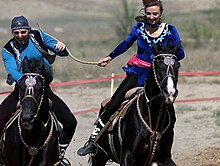Kazakh clothing
This article has multiple issues. Please help improve it or discuss these issues on the talk page. (Learn how and when to remove these messages)
|




Kazakh clothing is a style of clothing worn by Kazakh people, often made of material suited to the region's hot summers and cold winters.[1] Such garments may reflect social standing; contemporary Kazakhs commonly wear modern western clothing, but many still wear traditional clothing for holidays and on special occasions.[2]
Materials and production methods
Cloth, skin, felt, and fur are all traditional materials used for Kazakh clothing. Embroidery, fur, jewelry and ornamentation may also be used for decoration.
For those able to afford the expense, imported materials such as silk, brocade and velvet are sewn into clothes.
Hides are used for coat-making in a process that includes skinning, drying, and greasing with sour milk mixed with flour. After four days, the skins are washed and stacked in heavily salted water. After a further period of drying, the inner side is scraped with a special knife, before being warmed, which imparts a whitish color to the skin. The skin is now ready for dying in various colours: yellow dye is made by boiling the crushed root of a taranovy plant; red dye is made from the root of a plant named uiran boyau and orange dye is often made from the dried crusts of pomegranates.
Kazakhs use white wool, and consider wool from the neck of the sheep and camel to be particularly valuable.
Fabric may be home-spun and produced on primitive horizontal machines; even in ancient times, imported cotton, silk and woolen fabrics were used by Kazakh nomads. The nobility in feudal times used imported fabrics to make clothes while less affluent Kazakhs wore fur, leather and self-made woolen products.
Women's clothes
Koylek
Women wear a shirt-like garment known as a koylek. It is sewn from different fabrics depending on the purpose - from inexpensive fabrics for daily use to more expensive ones for festive wear. The dress is made by folding an integral piece of fabric in half and sewing the sides laterally from the armpits to the bottom hem.
Trousers
Kazakh girls wear trousers sewn from a sheepskin, homespun cloth, and dense cotton fabrics. Trousers may be short (shalbar) or long (dalbar).
Saukele
A saukele is a wide dressing gown with long sleeves while a wedding gown is often a saukele made of expensive red fabric.
Kupe
A kupe is warm women's clothing typically made of fox fur, and is rarely made from goat skin.
Female headdress
Headdresses indicate the relationship status of a woman: unmarried girls wear a skullcap and a warm cap with a fur edge. For rich girls, these hats are made of a bright velvet and embroidered with golden thread.
Brides
The headdress of the bride is called a саукеле. Poor women make this headdress from cloth or sateen then decorate it with glass beads. Long suspension brackets (zhaktau) are then added. Zhaktau are fastened from the lateral faces using belts that fall just below.[clarification needed Fall just below what?]
Childbirth
After the birth of her first child, a woman puts on a headdress made from white fabric, and often wears it for the rest of her life. Details of the headdress vary depending on the region while the base consists of two parts: the bottom (kimeshka) is placed on the head then the top is twisted into the form of a turban.
Men's apparel
Men wear two types of skin shirts without an undervest, a pair of inner and outer trousers along with loose fitting outer clothing such as dressing gowns made from various materials. Leather and cloth belts are obligatory parts of a suit.
Shalbar
In the 18th century the top trousers or shalbar were sewn from homespun camel-hair fabric and skin. They bore embroidered silk patterns in designs shaped like vegetables, the ends quite often sheathed by an ornate band, lace, and edged with fur.
Camisole
Camisoles were sewn from monochrome dark fabrics and occasionally from striped or motley fabrics. They had a cloth lining often insulated by a thin layer of wool.
Shapan
One of the main articles of clothing of the Kazakh was the shapan or chapan - a spacious long dressing gown.[3] Shapan are sewn from various fabrics, easy and dense, in various colours although in the main monochrome or dark. These are lined with a layer of wool or cotton wool. Festive shapan are sewn from velvet and decorated with applique, brushes, and gold embroidery. Such a dressing gown was part of the clothing of rich Kazakhs.
Ton
A Ton or sheepskin coat is a common article of winter clothing for Kazakhs. Tons are made by sewing together tanned sheepskins and contain wool on the inside. Prosperous Kazakhs wear tons made from the skins of four- to five-month-old lambs.
References
- ^ [1] Fergus, Michael and Jandosova, Janar, "Kazakhstan: Coming of Age," Stacey International, 2003, page 216. ISBN 978-1900988612
- ^ [2] Waters, Bella "Kazakhstan in Pictures," Twenty First Century Books; 2nd edition, 2007, page 37. ISBN 978-0822565888
- ^ [3] Hanks, Reuel R., "Central Asia: a global studies handbook," ABC-CLIO, 2005, page 232. ISBN 978-1851096565

